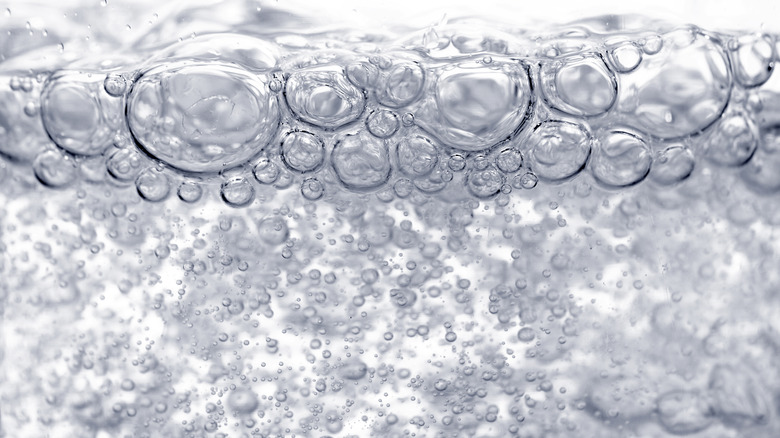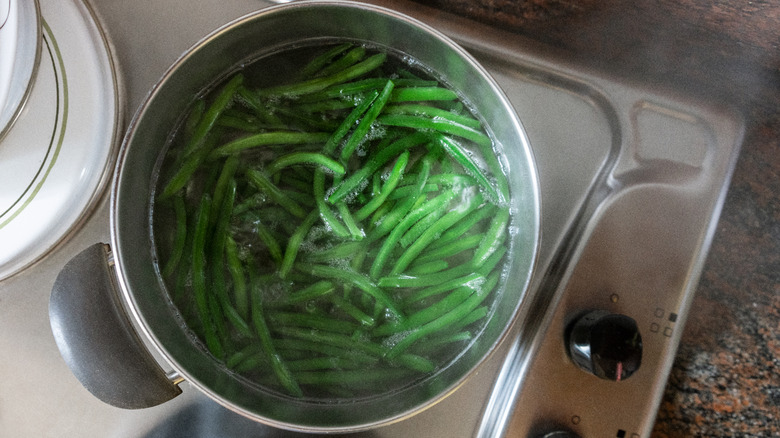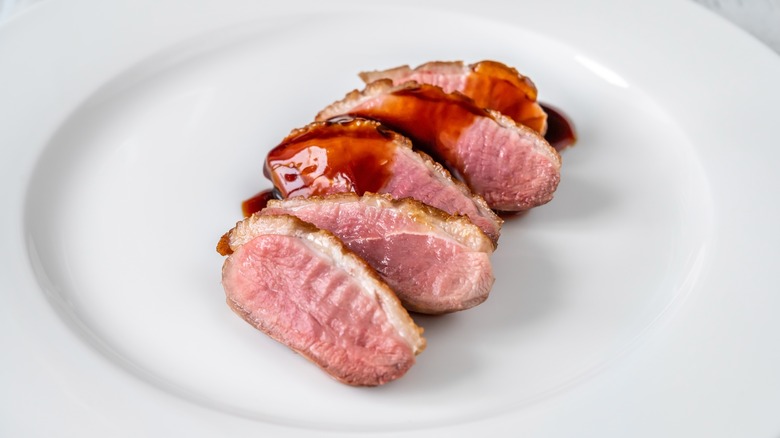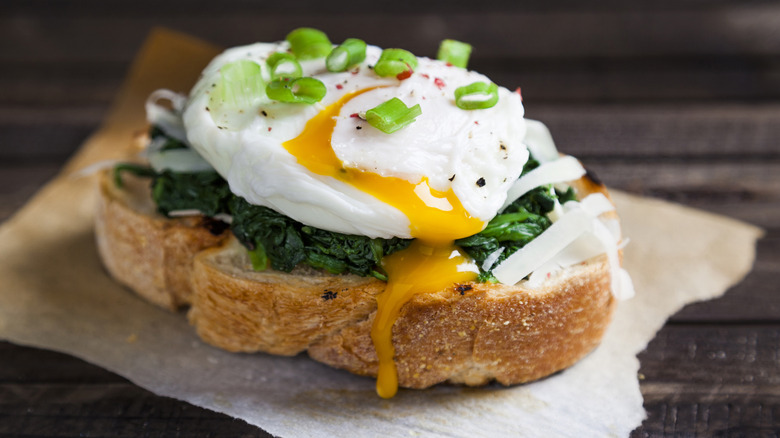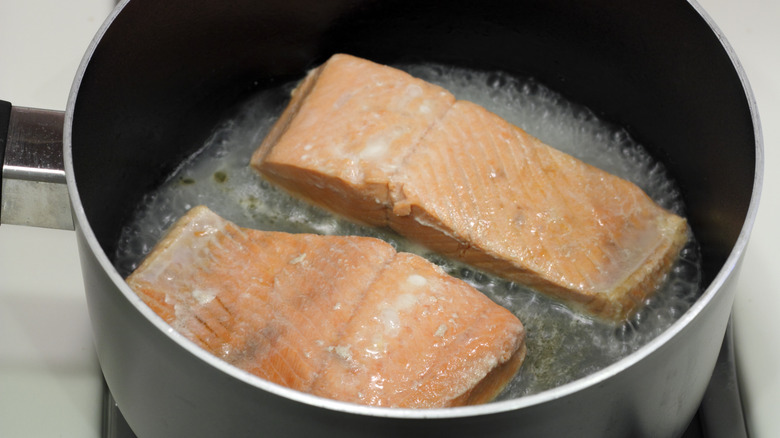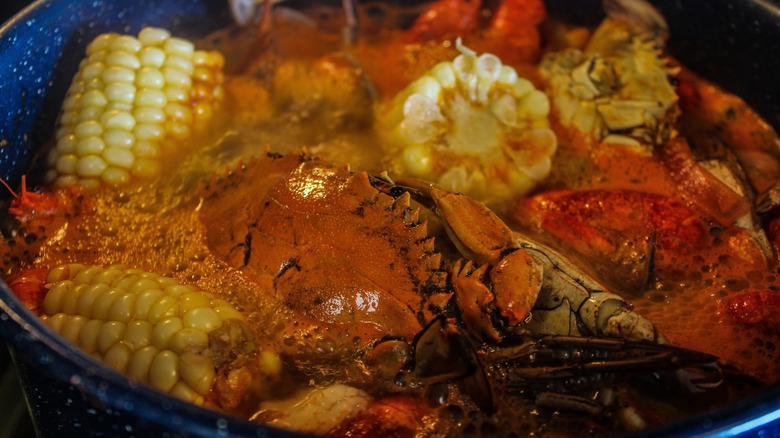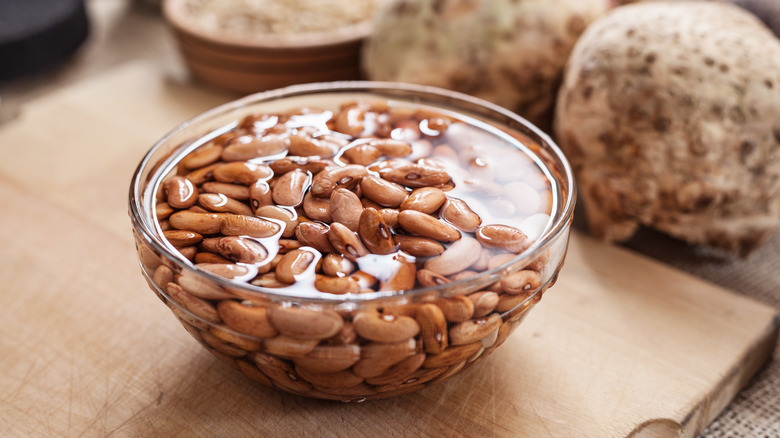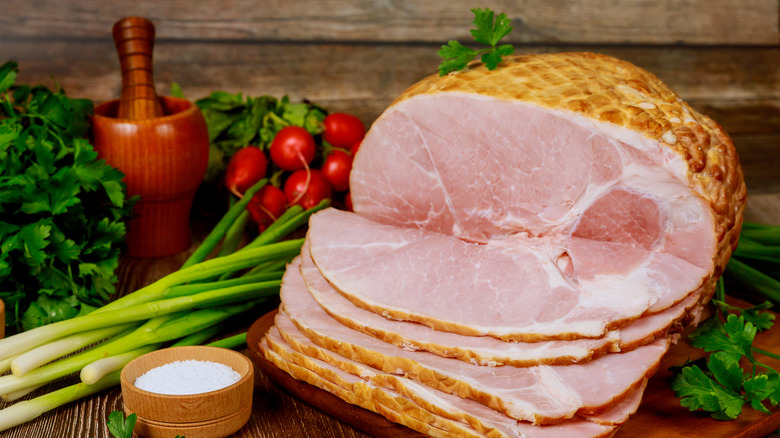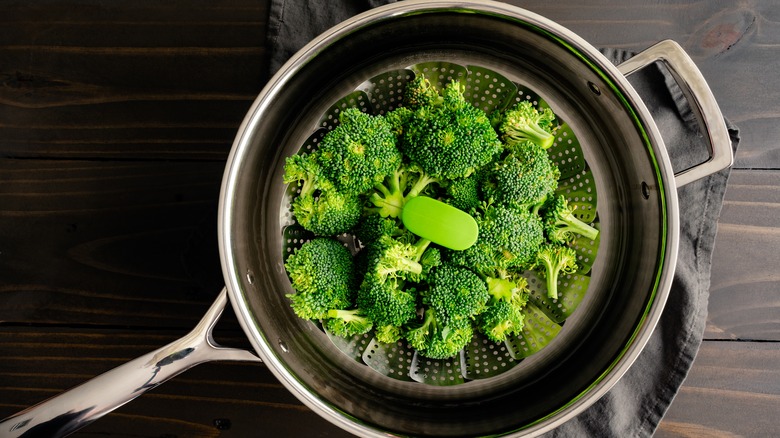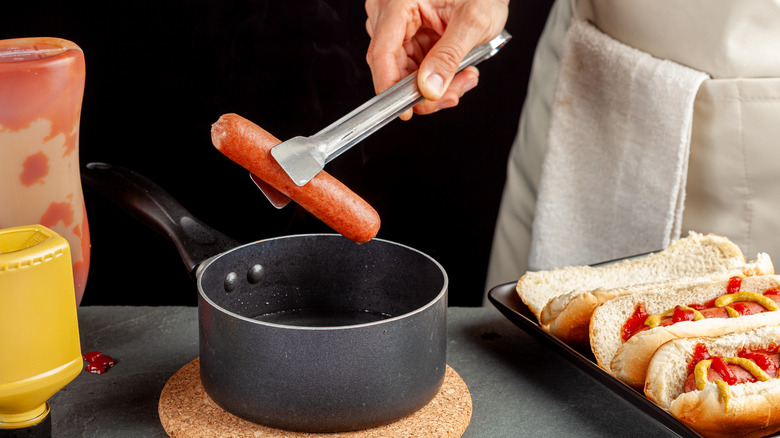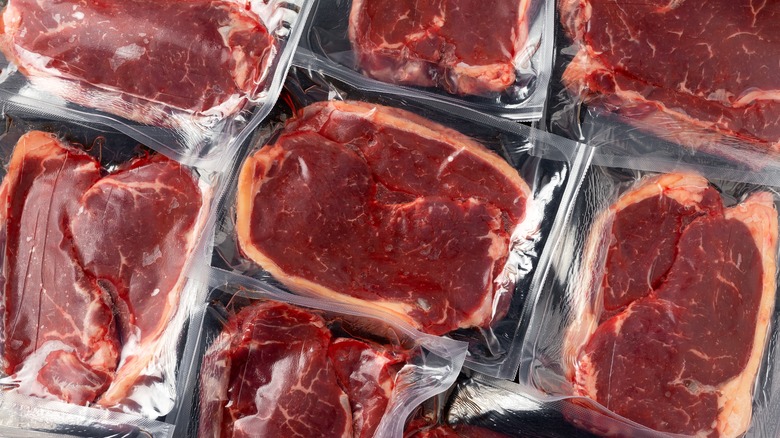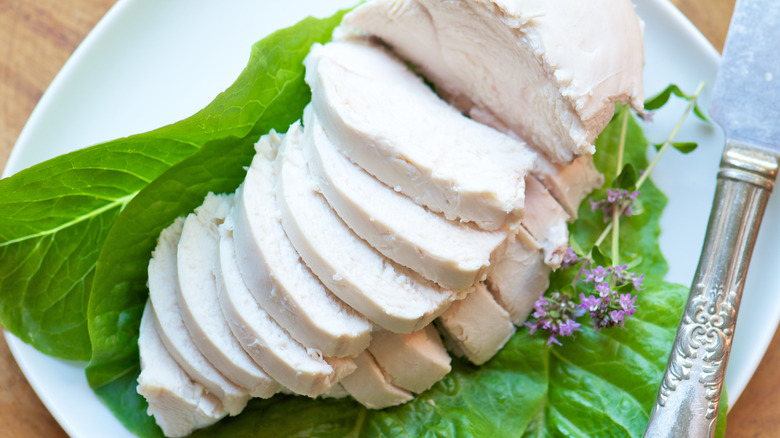Water Is The Best Way To Cook These 11 Foods
Cooking with water sometimes gets a bad rap. We tend to think of boiled foods as bland, boring, and soggy, while buttery pan-fried dishes or smoky chargrilled meats get all the culinary glory. However, many chefs in high-end restaurants swear by water-based cooking methods to prepare premium ingredients. You can even think of water-based cooking as the ultimate primer in a professional kitchen.
There are also lots of different ways to cook with water — from poaching to steaming to braising. While a good, hard boil is the best way to cook some foods, poaching and steaming are incredibly light cooking styles that can enhance delicate flavors and lock in water-soluble nutrients in some ingredients. Cooking with water is also a great way to cut back on extra oil and make many dishes lower in fat. If you want a new way to cook these 11 foods, it all starts with some basic H2O.
1. Blanch your green beans to give them a snappy crunch
Green beans are delicious, pan-fried in butter or sautéed in oil. If you want to finish your beans like this, you should cook them in water first. We don't mean boil them to death — the over-boiled green bean is probably the most iconic badly-cooked foods that puts people off veggies for life. Instead, you can use the blanch and shock method to perfectly prep your green beans.
Blanching green beans means giving them an extremely quick boil — just a few minutes in the pot — before tossing them into an ice bath to shock them cold. This process deactivates potentially harmful lectin proteins in raw beans, helps them retain a bright green color, and locks in minerals and nutrients. Blanching and shocking green beans also help you get the texture just right. Properly blanched beans will have a snappy bite without feeling rubbery or hard to chew.
Once you've blanched your beans, toss them in a pan and give them a quick fry to finish. You can also consume blanched green beans hot, freeze them for later, or chill them and serve them in a salad. Blanching also allows you to refrigerate for later use such as reheating your green beans in the air fryer for a delectable crunch.
2. Duck breast can be cooked in a water bath
Sous vide duck breast is a popular restaurant preparation that involves cooking duck in a temperature-regulated water bath. Cooking duck sous vide cuts back on temperature fluctuations, which occur more frequently in ovens and stovetops, and helps cook the meat evenly throughout. This technique also works great during a busy service, as chefs can set the water bath temperature and leave the duck to cook without having to check on it regularly. The duck can then be crisped up in a pan to give it that golden, restaurant-level sear.
So, how does sous vide duck breast work? First, the duck breast is marinated or seasoned and then placed in a vacuum-sealed bag. This helps to hold in flavors, juices, and nutrients. The vacuum bag is then placed in the water bath and left to cook for anywhere between 45 minutes to 4 hours at around 130 degrees Fahrenheit.
In most professional kitchens, chefs will use a specific sous vide cooker to ensure their temperatures are completely accurate. However, if you want to experiment with sous vide cooking at home, you can buy an immersion circulator, which controls water temperatures and can be used in a regular pot. You won't necessarily be able to tell the difference between pan-cooked and sous vide meat when dining at a restaurant, but if you're eating perfectly cooked duck breast that's moist and tender, chances are it has been prepared in a water bath.
3. Poached eggs are the ultimate breakfast food
While fried eggs and scrambled eggs are breakfast classics, mastering the poached egg will take your mornings to a whole new level, and it's healthier, given no oil or fat is needed. Poached eggs are quick and simple to make — all you need are fresh eggs and a pot of water. Heat your water to just below a rolling boil, crack your eggs into a dish, and gently slide them into the pan. Allow the eggs to cook for 3-4 minutes, then use a slotted spoon to carefully lift them out of the water without breaking the yolk.
For best results, remember to give the water a brisk stir before adding your eggs. This creates a vortex and helps the white cling to the egg, forming a firm, round shape instead of a loose, wispy egg. Some common mistakes you're probably making when poaching eggs include crowding the pan – stick to poaching 1-2 eggs at a time or using an egg poacher with separate baskets — and not adding vinegar to your water to help firm up the whites.
Once you've got egg poaching down to a fine art, you can serve poached eggs over ham or with smoked salmon and a creamy hollandaise sauce. Poached eggs also work well with avocado and a sprinkle of salt and pepper for a breakfast packed with protein and healthy fats.
4. Salmon filets are juicy and nutritious when cooked in water
Poaching salmon in water is a quick and healthy way to create moist, juicy fish filets. You can make poached salmon at home in less than 20 minutes using a large pan, some water, and a few garnishes. As this is a simple preparation, fish quality will make a big difference to the final taste, so aim to use fresh wild salmon or top-end farmed salmon for poached dishes.
To start your meal, add your water to the pan and throw in some chopped onions or shallots and some fresh herbs. You can also make a mirepoix base of onions, celery, and carrots to add flavor to your stock. Leave the skin on your salmon filets and put them in the pan once the water has reached a simmer. You can fully submerge the filets in water or just let the water surround them so they partially steam.
Poached salmon filets are great if you want a meal that's high in healthy fats and omega-3 from the fish but contains no oil. You can also add some extra seasonings — like some white wine or lemon slices — to the water to give the fish a tart, zesty kick.
5. A crab boil is the ultimate in simple seafood
When preparing crab meat, it's best to keep things simple. A classic crab boil is an easy one-pot recipe that works well with fresh, whole crabs or frozen crabs. Like many water-based dishes, a crab boil starts with a large pot of water — enough to cover all your ingredients. Season your water with salt, lemon slices, and herbs or spices then bring it to a boil. Roughly chop your veggies — staple ingredients can include potatoes, corn, and onions — and add them to the pot to cook through.
When putting your seafood in the boil, be careful with the timing. Frozen crab legs will only need 3-5 minutes in the water to heat through, while whole, raw crabs will need between 10-20 minutes. If you're wondering about different types of crab and how to eat them, good options for a crab boil include Dungeness crab, king crab, and snow crab. You can also throw in a mix of different seafood — just be sure you monitor the various timings as each crustacean will cook at a slightly different rate.
To serve your crab boil, lift the shellfish out with tongs and scoop or drain your veggies from the water. You can also keep back some of the broth to pour over your meal or lightly toss the boiled ingredients in a pan with butter.
6. Use water to prep dried beans
Water is essential when prepping dried beans for dishes like chili or refried beans. While tinned pinto beans and canned black beans can be refried, dried beans packs more punch in terms of flavor and texture. Dried beans allow you to cook them for longer, making the skins extra soft for smooth bean mashes, like hummus or bean dip. Canned beans also tend to be higher in salt, which you can eradicate if you're working with dried beans and want to watch your sodium intake.
To make dried beans, you'll need to soak them in water overnight before cooking. You can then throw them in a pot, cover them with cold water, and cook for around 1-2 hours or until soft. Although dried beans don't score much higher than canned beans in nutrient content, beans are a seriously healthy food, containing high quantities of fiber, iron, potassium, and folate. You'll also find that your money goes further, as a serving of canned beans is more than double the price compared to dried beans.
7. A briny boil makes perfect cooked ham
When you're serving a crowd, making a roast can feel daunting. Plus, you don't want to be rushing around trying to get everything on the table while your guests have fun without you. While the classic roast pork has its place, a ham boil is a brilliant water-based compromise when you want a hearty, low-maintenance meal. To make a boiled ham, you'll want to buy a smoked or cured ham joint — these cuts are pre-cooked and have a rich, salty flavor. Boiling your ham with the bone in will yield the best results and help the meat stay moist and flaky.
You can boil ham in any large stovetop pot if it's deep enough to cover the whole joint with water and has a lid to seal in steam. Place your ham in the pot, cover it with cold water, and season your pot with herbs and garnishes — be careful adding salt as cured ham is already salty. Once the pot has come to a boil, turn down the heat, put the lid on, and allow the ham to simmer. 15-20 minutes per pound of ham is a good way to time it.
Add your pulled ham to a lentil or pea soup, or eat it cold in sandwiches. A boiled country ham will last around one week in the fridge.
8. For crunchy broccoli try cooking with steam
Soggy, boiled broccoli may be the stuff of food nightmares, but steamed broccoli is an entirely different matter. Steaming broccoli involves cooking it over water but keeping it separate from the liquid which helps retain water-soluble nutrients. Broccoli is a super healthy food loaded with fiber, vitamin C, and protein. Preparing steamed broccoli is also quick and easy, making this a great go-to vegetable to throw in a salad or serve with meat or fish.
Start by boiling your kettle then pour the water into a pan on the heat. Put your steaming basket on top and add your chopped broccoli. Set a timer for 5 minutes, and then check your broccoli.
If it's still too crunchy, give it one more minute and then serve. You can also steam broccoli by cooking it in the microwave with 2-3 teaspoons of water for around 5 minutes.
9. Conquer the cookout by boiling your hot dog sausages
The smell of sausages smoking on the grill is a sure sign that summer's in the air. While BBQing your hot dogs will ultimately get the most mouthwatering results, giving your sausages a quick boil beforehand helps things along. If you're using defrosted hotdogs, boiling them before grilling can help ensure they are fully thawed, leading to a more even cook. Undercooked meat is one of the most common food safety mistakes that can ruin a summer BBQ so anything that reduces that risk is worth doing.
Boiling your hot dogs before grilling can also improve the casing structure, making it less likely that they will split or burst on the BBQ. You don't need to boil hotdogs for long – 3-5 minutes is usually enough — but this short prep can make a big difference.
If you're not a fan of BBQ, boiled hot dogs can also be a dish in themselves. Pre-cooked hot dog sausages can be fully boiled and ready to eat in around 3-6 minutes and are great for achieving that fun, fairground feel with your summer snacks. Just make sure you've got some tongs on hand to whip them out of the water when they're done and some mustard or ketchup (or both) to squeeze on top.
10. Sous vide steak to enhance delicate cuts
You might recoil at seeing the words boiling and prime steak together in the same sentence. However, you may be surprised to learn that cooking your steak in water before searing can lead to some amazingly perfect meat. Like other proteins, steaks can be prepared sous vide — sealed in a vacuum pack and then slowly cooked in a water bath. Sous vide is a great cooking method if you struggle to judge the doneness of your steak in the pan, where temperature fluctuations across the pan's surface can lead to variations in how the meat cooks.
Sous vide cooking holds the steak at the same temperature for a long time, meaning that it cooks really evenly. Preparing steaks sous vide also makes timing easier, especially if you're cooking for a group. You don't have to risk one steak drying out or burning on the hob while you cook another — they can be hot-held in the sous vide for up to 4 hours.
Cooking steaks in a water bath is also a surprisingly great option for premium cuts. While filet mignon is one meat you should avoid cooking on the grill if you're not confident about timings and temperatures, the sous vide method is a gentle way to cook this tender cut.
11. For juicy chicken breast try poaching
Poached chicken is a healthy, no-frills way to add some protein to your diet It's also low in fat as there's no need to add oil when cooking. This water-based method also allows you to cook skinless chicken breasts without drying them out.
To make poached chicken breast, add your aromatics — typical ingredient suggestions include things like lemon slices, bay leaves, garlic, and sliced shallots — and your chicken breasts to a pan, cover with water, and put it on the heat. You can also boil the seasoned water first and add your chicken breast once the water is hot. When the water is bubbling, you should cover the pot with a lid and either turn the heat down or take it off the stove and leave it for around 10-20 minutes. Once your chicken is done, drain the water and serve the breast whole or slice it up for sandwiches or to top a chicken salad.
